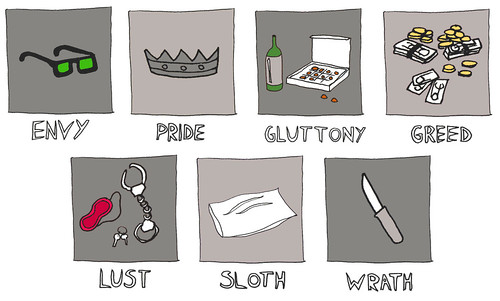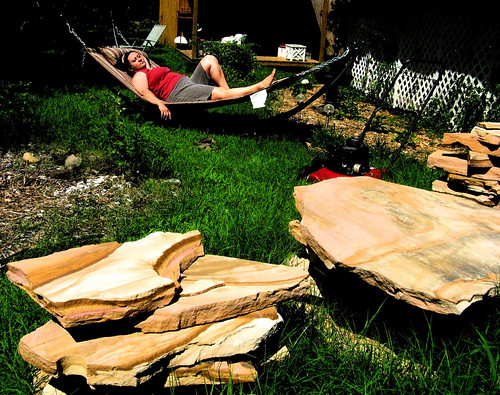The Seven Deadly Sins of Land Use
I have been invited to participate in a program tonight on sloth. I'm even featured, promoted. How should I feel about this? Embarrassed? Insulted? Proud, in effect compounding one deadly sin with another?
The program is sponsored by the New York Academy of Sciences, and it is more specifically titled "Sloth: Is Your City Making You Fat?" I want to scream, NO! It's this damn herniated disk that's making me fat, and I possibly just gave you too much information. I will say that being a (temporary, I hope) cripple on crutches does give one a different perspective on this walkability stuff. Find me a convenient parking space, please.
Anyway, the program seems to be one in a series sponsored by the Academy on "Science and the Deadly Sins." I think they invited me for sloth rather than, say, lust because I have written about how America's relatively unwalkable environment is, in fact, making us fat. They are right about that: I've written about cities and walkable neighborhoods (or the lack thereof) over 50 times in this space, according to my blog's archives.
So this got me to thinking about whether the traditional seven deadly sins correlated with problems with land use in America. I think they do. For example, let me count the ways, in alphabetic order:
ENVY – Nothing drives a cash-strapped jurisdiction nuts as much as watching a neighboring town/county/state land the next big corporate headquarters, stadium, business park, or big development, preferably without too many school-age kids to educate. If only it worked. Instead, the tax breaks, infrastructure and, down the road (literally) service and maintenance costs soon wipe out any short-term revenues, causing the jurisdiction to go into more debt, which it seeks to pay by chasing more sprawling development. Envy, it turns out, doesn't serve us well. My friend Chuck Marohn is making a career of detailing why this chasing-after-development is essentially a government-run Ponzi scheme, and he's right.
GLUTTONY – Sprawl means driving, and lots of it, to reach spread-out destinations. This led to rapid increases in vehicle miles traveled and gasoline consumed for decades until consumption began to level off in the 2000s and dropped somewhat during the recent economic slump. But US oil demand remains at an unsustainable level, between 18 and 19 million barrels per day.
In America, transportation accounts for 70 percent of total oil consumed, amounting to about 220 billion gallons of liquid hydrocarbon fuel per year. We have approximately 250 million personal vehicles registered, accounting for about 25 percent of all personal vehicles in the world. About 60 percent of these are cars, the remainder comprising SUVs, pick-up trucks and motorcycles. Globally, demand for oil is rising sharply; the International Energy Agency forecasts that demand for oil in China will increase some 60 percent from 2005 levels by 2035; demand for oil in India is expected to more than double during the same time period.
GREED – We all want businesspeople, including builders and developers, to make a profit. But how much, and at what social and environmental cost? As most readers know, I'm a fan of moderately dense, people-friendly development; in most neighborhoods, this means a mix of single-family, attached, and multi-family housing, not all the same kind; in neighborhood commercial districts, it may means three- to six-story buildings, not ten to twelve; in most downtowns, it means contributing green space, green infrastructure and community services to soften the effect of a high-rise scale.
But moderation, by definition, means accepting a reasonable, but not necessarily maximum, profit. Developers seldom want to do these things, which is one reason it troubles me deeply that some smart growth organizations are now actively soliciting contributions from developers but (by coincidence?) not pressing them to employ more green practices.
LUST – Americans seem to crave more of everything, from ridiculously large homes to living-room-scaled cars. While, as with driving rates, these trends seem to be moderating a bit, the average new home size in America remains four times larger today than it was in 1950, even though household size has gotten smaller. As for cars, a Honda Civic had gotten 20 percent longer and 19 percent wider between 1973 and 2008; a Volkswagen Golf had gotten 13 percent longer during roughly the same time period; our lust for Bigger SUVs has meant that a Ford Explorer, still the most popular model, grew 7 percent in length, 13 percent in width, and 25 percent in weight in just 13 years from 1998 to 2011.
PRIDE – I don't hate "starchitecture" as much as many of my friends do. I love Frank Gehry's Disney Hall, Cesar Pelli's Washington National Airport terminal, Jorn Utzon's Sydney Opera House, and most anything by Gaudi. Iconoclasm can be a good thing, making us see the world – or our city – in new ways. But not too much of it, please. Fred Kent is essentially right when he says that few of these iconic buildings create good public spaces and street life. So I think it can be OK in occasional doses, but not in abundance. And "The Crystal" expansion of the Royal Ontario Museum in Toronto? Heaven help us.
SLOTH – This may surprise a new reader (but it won't surprise long-timers): the laziness that most offends me is within our own community - a failure of urbanist and smart-growth advocates to demand more of our built environment. I won't belabor the point, since I've said it so often, but advocating infill, density and transit is no longer enough in the 21st century. Since the modern smart growth movement was conceived in the 1990s, there have been striking advances in thinking about green infrastructure, green buildings, healthy food systems, placemaking, equitable economic development, public health and the built environment, and more. If these things aren't front and center of our agenda, we're not doing our jobs.
WRATH - OMG. The "Agenda 21" paranoid crazies. Need I say more?
Any other nominations?
Move your cursor over the images for credit information.









